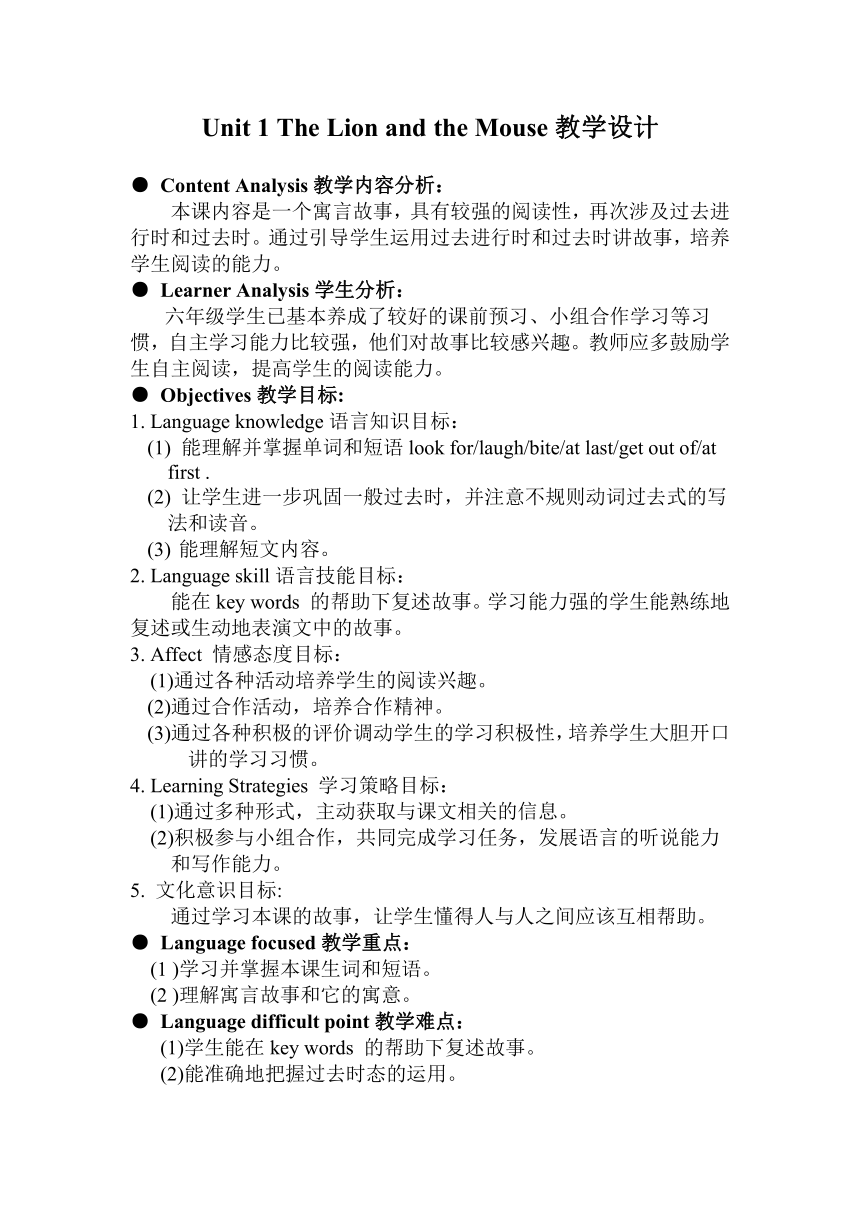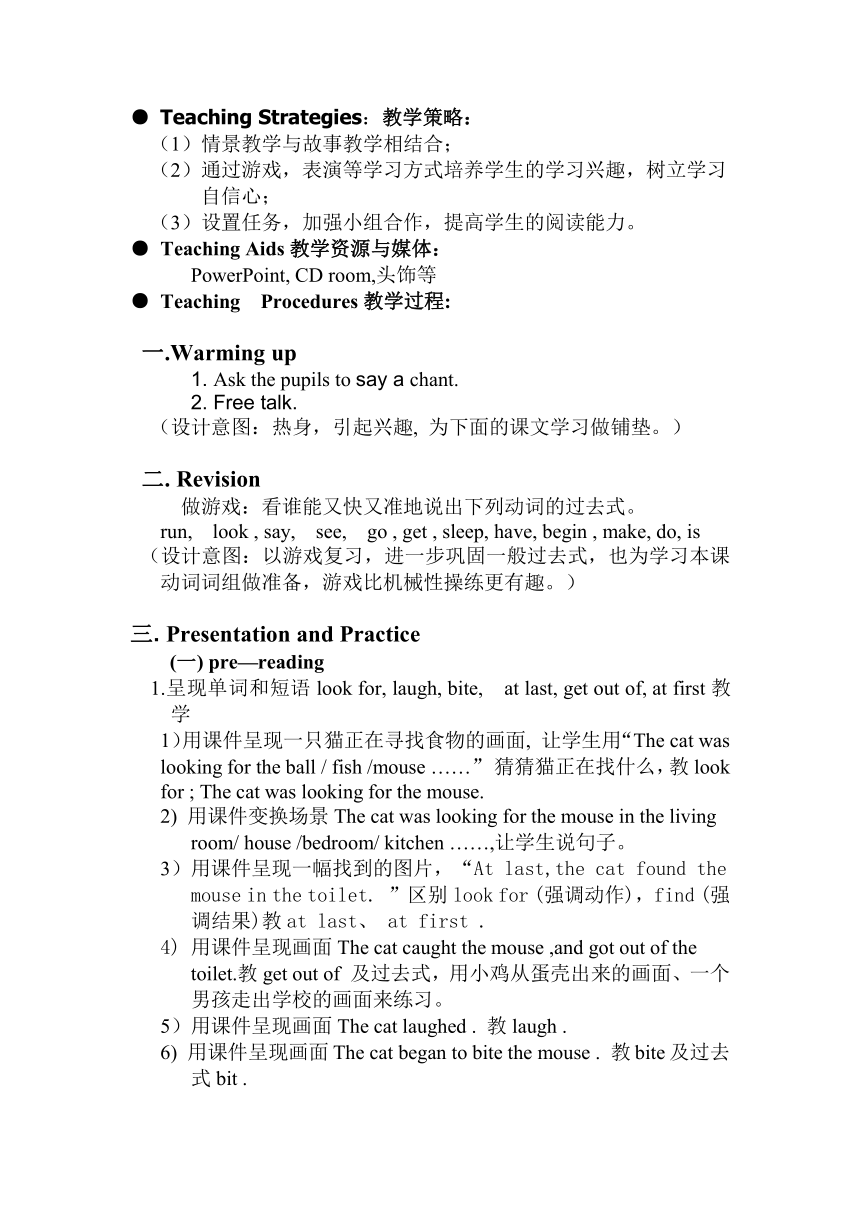牛津译林苏教版六年级下册(新版)Unit 1 The lion and the mouse 教案
文档属性
| 名称 | 牛津译林苏教版六年级下册(新版)Unit 1 The lion and the mouse 教案 |  | |
| 格式 | zip | ||
| 文件大小 | 20.2KB | ||
| 资源类型 | 教案 | ||
| 版本资源 | 牛津苏教版 | ||
| 科目 | 英语 | ||
| 更新时间 | 2014-12-30 12:53:34 | ||
图片预览


文档简介
Unit 1 The Lion and the Mouse教学设计
● Content Analysis教学内容分析:
本课内容是一个寓言故事,具有较强的阅读性,再次涉及过去进行时和过去时。通过引导学生运用过去进行时和过去时讲故事,培养学生阅读的能力。
● Learner Analysis学生分析:
六年级学生已基本养成了较好的课前预习、小 ( http: / / www.21cnjy.com )组合作学习等习惯,自主学习能力比较强,他们对故事比较感兴趣。教师应多鼓励学生自主阅读,提高学生的阅读能力。
● Objectives教学目标:
1. Language knowledge语言知识目标:
(1) 能理解并掌握单词和短语look for/laugh/bite/at last/get out of/at first .
(2) 让学生进一步巩固一般过去时,并注意不规则动词过去式的写法和读音。
(3) 能理解短文内容。
2. Language skill语言技能目标:
能在key words 的帮助下复述故事。学习能力强的学生能熟练地复述或生动地表演文中的故事。
3. Affect 情感态度目标:
(1)通过各种活动培养学生的阅读兴趣。
(2)通过合作活动,培养合作精神。
(3)通过各种积极的评价调动学生的学习积极性,培养学生大胆开口讲的学习习惯。
4. Learning Strategies 学习策略目标:
(1)通过多种形式,主动获取与课文相关的信息。
(2)积极参与小组合作,共同完成学习任务,发展语言的听说能力和写作能力。
5. 文化意识目标:
通过学习本课的故事,让学生懂得人与人之间应该互相帮助。
● Language focused教学重点:
(1 )学习并掌握本课生词和短语。
(2 )理解寓言故事和它的寓意。
● Language difficult point教学难点:
(1)学生能在key words 的帮助下复述故事。
(2)能准确地把握过去时态的运用。
● Teaching Strategies:教学策略:
(1)情景教学与故事教学相结合;
(2)通过游戏,表演等学习方式培养学生的学习兴趣,树立学习自信心;
(3)设置任务,加强小组合作,提高学生的阅读能力。
● Teaching Aids教学资源与媒体:
PowerPoint, CD room,头饰等
● Teaching Procedures教学过程:
一.Warming up
1. Ask the pupils to say a chant.
2. Free talk.
(设计意图:热身,引起兴趣, 为下面的课文学习做铺垫。)
二. Revision
做游戏:看谁能又快又准地说出下列动词的过去式。
run, look , say, se ( http: / / www.21cnjy.com )e, go , get , sleep, have, begin , make, do, is
(设计意图:以游戏复习,进一步巩固一般过去式,也为学习本课动词词组做准备,游戏比机械性操练更有趣。)
三. Presentation and Practice
(一) pre—reading
1.呈现单词和短语look for, laugh, bite, at last, get out of, at first教学
1)用课件呈现一只猫正在寻找食物的画面, ( http: / / www.21cnjy.com )让学生用“The cat was looking for the ball / fish /mouse ……” 猜猜猫正在找什么,教look for ; The cat was looking for the mouse.
2) 用课件变换场景The ( http: / / www.21cnjy.com ) cat was looking for the mouse in the living room/ house /bedroom/ kitchen ……,让学生说句子。
3)用课件呈现一幅找到的图片,“At ( http: / / www.21cnjy.com )last,the cat found the mouse in the toilet. ”区别look for (强调动作),find (强调结果)教at last、 at first .
4) 用课件呈现画面The cat ( http: / / www.21cnjy.com ) caught the mouse ,and got out of the toilet.教get out of 及过去式,用小鸡从蛋壳出来的画面、一个男孩走出学校的画面来练习。
5)用课件呈现画面The cat laughed . 教laugh .
6) 用课件呈现画面The cat began to bite the mouse . 教bite及过去式bit .
(设计意图:以猫和老鼠的故事引出本课的新单词和词组,学生会容易理解;同时在故事中穿插句型操练,学生不会感到枯燥,这符合孩子的年龄特点。)
2.操练单词和短语。
让学习能力强的同学做“小老师”带读 ( http: / / www.21cnjy.com ),老师及时纠正读错的单词。2分钟时间,四人小组内过关新单词,老师在课堂上抽查困难学生的上口情况,并给过关的小组加分。
(设计意图:让学生带读新单词,增加学生学习成就感,刺激其他学生培养课前听读预习的学习习惯,促进学习策略的形成,培养小组合作的精神。)
(二)while reading
1.呈现、理解故事,学习课文。
1)Teacher introduces the title of Unit 11 The Lion and the Mouse.
2)Listen and watch the Flash of the story .让学生初步感知课文。
3)Pupils work in groups, and put the sentences in the right order.
4)Check out the answers.
(设计意图:学生看寓言的卡通,让学生对寓言故 ( http: / / www.21cnjy.com )事有一个整体理解。学生通过四人小组活动,把句子排序,检查学生理解故事的情况。也为下面的复述故事提供帮助和示范。)
5)Look and li ( http: / / www.21cnjy.com )sten again, then read the story and answer the questions following. (用课件呈现)
Q1: Who did the lion catch one day
Q2: Did the lion eat the mouse up
Q3: Did the lion think the mouse was too small for a meal
Q4: Did the mouse think he could help the lion
Q5: Did the lion think the mouse could help him at first
Q6: Was the lion in a net one day Could he get out of it
Q7: How did the mouse help the lion
Q8: Do you think the small can help the great
(设计意图:练习题型设置由浅入深,学生会较容易接受。)
6)Pupils read the story after the tape .
7)Pupils rea ( http: / / www.21cnjy.com )d the story together and try to imitate the tones of the lion and the mouse.
8)Read the story in groups
(设计意图:在学生初次朗读故事后,通过 ( http: / / www.21cnjy.com )老师的指导,让学生模仿狮子和老鼠的语音语调,进行角色扮演朗读,增加朗读的乐趣,激发学生朗读寓言的兴趣,同时促进学生朗读能力和 语感的培养。)
(三)post-reading
Pupils share what they can learn from this story.
(设计意图:引导学生对寓言的进一步思考,让学生发现寓言的深层含义,得出寓言的主旨。)
四. Development and Conclusion
1.Act out the story in groups.
2.Pupils try to retell the story with the pictures and key words.
(设计意图:通过表演课文,让学生进一步熟悉课文后,学习能力较高的学生在图片和关键词和短语的帮助下,复述故事。)
3. Ask the pupils to write the ending of the story and talk about it.
(设计意图:同桌合作,3分钟完成,汇报。进一步拓展所学知识,进行综合运用)
五. Homework
1) Copy the new words
2) Retell the story to others.
● 板书设计:
Unit 1 The Lion and the Mouse
look for The mouse was looking for something to eat.
laugh —laughed
bite —bit That’s very good of you!
at last
at first The small can help the great.
get out of
● 教学反思
本节课是广州版Success With ( http: / / www.21cnjy.com ) English 第八册Unit 11 The Lion and the Mouse的第一课时。这则伊索寓言故事生动有趣,适合六年级学生学习。在课堂中,通过“阅读前—阅读中—阅读后”模式,使学生体会阅读技巧的成功运用,享受到阅读的乐趣。并通过学习和模仿不同角色的语音语调,培养学生的英语朗读能力和语感。在学习故事后,鼓励学生根据图片、提示短语,用过去时态复述故事,培养学生口头讲故事的能力。在拓展部分,鼓励学生尝试根据图片和短语写故事,培养学生的写故事的能力。这个呈螺旋式上升的教学设计,层层递进。纵观整节课的设计,从易到难,从理解到运用,从模仿到生成。这样的设计符合了英语语言学习的特点,遵从儿童的认知规律。上完这节课后,基本达到了我预设的教学目标。
在教学中,引发我对这节课的思考:学 ( http: / / www.21cnjy.com )生的学习能力存在差距,还有受到学生心理素质的影响,在课堂上,学生的表现不一。学习能力较强的学生,表演欲较高的学生表现活跃,而学习能力不是很高,有比较内向的学生在课堂上就比较沉默,如在表演课文部分,学生在四人小组练习后,老师的检查时表现得不是很积极。只有几个学习能力比较高的学生愿意表演。如果我在学生自己表演前,先让学生背诵狮子和老鼠的话,再多加鼓励,学生可能表演得更好。
在以后的教学中,我一定会不断探索和追求, ( http: / / www.21cnjy.com )用勤奋和创新引导我的学生掌握好英语这门课程,爱上英语,学好英语,更好地运用英语,我相信我一定能做到!
● Content Analysis教学内容分析:
本课内容是一个寓言故事,具有较强的阅读性,再次涉及过去进行时和过去时。通过引导学生运用过去进行时和过去时讲故事,培养学生阅读的能力。
● Learner Analysis学生分析:
六年级学生已基本养成了较好的课前预习、小 ( http: / / www.21cnjy.com )组合作学习等习惯,自主学习能力比较强,他们对故事比较感兴趣。教师应多鼓励学生自主阅读,提高学生的阅读能力。
● Objectives教学目标:
1. Language knowledge语言知识目标:
(1) 能理解并掌握单词和短语look for/laugh/bite/at last/get out of/at first .
(2) 让学生进一步巩固一般过去时,并注意不规则动词过去式的写法和读音。
(3) 能理解短文内容。
2. Language skill语言技能目标:
能在key words 的帮助下复述故事。学习能力强的学生能熟练地复述或生动地表演文中的故事。
3. Affect 情感态度目标:
(1)通过各种活动培养学生的阅读兴趣。
(2)通过合作活动,培养合作精神。
(3)通过各种积极的评价调动学生的学习积极性,培养学生大胆开口讲的学习习惯。
4. Learning Strategies 学习策略目标:
(1)通过多种形式,主动获取与课文相关的信息。
(2)积极参与小组合作,共同完成学习任务,发展语言的听说能力和写作能力。
5. 文化意识目标:
通过学习本课的故事,让学生懂得人与人之间应该互相帮助。
● Language focused教学重点:
(1 )学习并掌握本课生词和短语。
(2 )理解寓言故事和它的寓意。
● Language difficult point教学难点:
(1)学生能在key words 的帮助下复述故事。
(2)能准确地把握过去时态的运用。
● Teaching Strategies:教学策略:
(1)情景教学与故事教学相结合;
(2)通过游戏,表演等学习方式培养学生的学习兴趣,树立学习自信心;
(3)设置任务,加强小组合作,提高学生的阅读能力。
● Teaching Aids教学资源与媒体:
PowerPoint, CD room,头饰等
● Teaching Procedures教学过程:
一.Warming up
1. Ask the pupils to say a chant.
2. Free talk.
(设计意图:热身,引起兴趣, 为下面的课文学习做铺垫。)
二. Revision
做游戏:看谁能又快又准地说出下列动词的过去式。
run, look , say, se ( http: / / www.21cnjy.com )e, go , get , sleep, have, begin , make, do, is
(设计意图:以游戏复习,进一步巩固一般过去式,也为学习本课动词词组做准备,游戏比机械性操练更有趣。)
三. Presentation and Practice
(一) pre—reading
1.呈现单词和短语look for, laugh, bite, at last, get out of, at first教学
1)用课件呈现一只猫正在寻找食物的画面, ( http: / / www.21cnjy.com )让学生用“The cat was looking for the ball / fish /mouse ……” 猜猜猫正在找什么,教look for ; The cat was looking for the mouse.
2) 用课件变换场景The ( http: / / www.21cnjy.com ) cat was looking for the mouse in the living room/ house /bedroom/ kitchen ……,让学生说句子。
3)用课件呈现一幅找到的图片,“At ( http: / / www.21cnjy.com )last,the cat found the mouse in the toilet. ”区别look for (强调动作),find (强调结果)教at last、 at first .
4) 用课件呈现画面The cat ( http: / / www.21cnjy.com ) caught the mouse ,and got out of the toilet.教get out of 及过去式,用小鸡从蛋壳出来的画面、一个男孩走出学校的画面来练习。
5)用课件呈现画面The cat laughed . 教laugh .
6) 用课件呈现画面The cat began to bite the mouse . 教bite及过去式bit .
(设计意图:以猫和老鼠的故事引出本课的新单词和词组,学生会容易理解;同时在故事中穿插句型操练,学生不会感到枯燥,这符合孩子的年龄特点。)
2.操练单词和短语。
让学习能力强的同学做“小老师”带读 ( http: / / www.21cnjy.com ),老师及时纠正读错的单词。2分钟时间,四人小组内过关新单词,老师在课堂上抽查困难学生的上口情况,并给过关的小组加分。
(设计意图:让学生带读新单词,增加学生学习成就感,刺激其他学生培养课前听读预习的学习习惯,促进学习策略的形成,培养小组合作的精神。)
(二)while reading
1.呈现、理解故事,学习课文。
1)Teacher introduces the title of Unit 11 The Lion and the Mouse.
2)Listen and watch the Flash of the story .让学生初步感知课文。
3)Pupils work in groups, and put the sentences in the right order.
4)Check out the answers.
(设计意图:学生看寓言的卡通,让学生对寓言故 ( http: / / www.21cnjy.com )事有一个整体理解。学生通过四人小组活动,把句子排序,检查学生理解故事的情况。也为下面的复述故事提供帮助和示范。)
5)Look and li ( http: / / www.21cnjy.com )sten again, then read the story and answer the questions following. (用课件呈现)
Q1: Who did the lion catch one day
Q2: Did the lion eat the mouse up
Q3: Did the lion think the mouse was too small for a meal
Q4: Did the mouse think he could help the lion
Q5: Did the lion think the mouse could help him at first
Q6: Was the lion in a net one day Could he get out of it
Q7: How did the mouse help the lion
Q8: Do you think the small can help the great
(设计意图:练习题型设置由浅入深,学生会较容易接受。)
6)Pupils read the story after the tape .
7)Pupils rea ( http: / / www.21cnjy.com )d the story together and try to imitate the tones of the lion and the mouse.
8)Read the story in groups
(设计意图:在学生初次朗读故事后,通过 ( http: / / www.21cnjy.com )老师的指导,让学生模仿狮子和老鼠的语音语调,进行角色扮演朗读,增加朗读的乐趣,激发学生朗读寓言的兴趣,同时促进学生朗读能力和 语感的培养。)
(三)post-reading
Pupils share what they can learn from this story.
(设计意图:引导学生对寓言的进一步思考,让学生发现寓言的深层含义,得出寓言的主旨。)
四. Development and Conclusion
1.Act out the story in groups.
2.Pupils try to retell the story with the pictures and key words.
(设计意图:通过表演课文,让学生进一步熟悉课文后,学习能力较高的学生在图片和关键词和短语的帮助下,复述故事。)
3. Ask the pupils to write the ending of the story and talk about it.
(设计意图:同桌合作,3分钟完成,汇报。进一步拓展所学知识,进行综合运用)
五. Homework
1) Copy the new words
2) Retell the story to others.
● 板书设计:
Unit 1 The Lion and the Mouse
look for The mouse was looking for something to eat.
laugh —laughed
bite —bit That’s very good of you!
at last
at first The small can help the great.
get out of
● 教学反思
本节课是广州版Success With ( http: / / www.21cnjy.com ) English 第八册Unit 11 The Lion and the Mouse的第一课时。这则伊索寓言故事生动有趣,适合六年级学生学习。在课堂中,通过“阅读前—阅读中—阅读后”模式,使学生体会阅读技巧的成功运用,享受到阅读的乐趣。并通过学习和模仿不同角色的语音语调,培养学生的英语朗读能力和语感。在学习故事后,鼓励学生根据图片、提示短语,用过去时态复述故事,培养学生口头讲故事的能力。在拓展部分,鼓励学生尝试根据图片和短语写故事,培养学生的写故事的能力。这个呈螺旋式上升的教学设计,层层递进。纵观整节课的设计,从易到难,从理解到运用,从模仿到生成。这样的设计符合了英语语言学习的特点,遵从儿童的认知规律。上完这节课后,基本达到了我预设的教学目标。
在教学中,引发我对这节课的思考:学 ( http: / / www.21cnjy.com )生的学习能力存在差距,还有受到学生心理素质的影响,在课堂上,学生的表现不一。学习能力较强的学生,表演欲较高的学生表现活跃,而学习能力不是很高,有比较内向的学生在课堂上就比较沉默,如在表演课文部分,学生在四人小组练习后,老师的检查时表现得不是很积极。只有几个学习能力比较高的学生愿意表演。如果我在学生自己表演前,先让学生背诵狮子和老鼠的话,再多加鼓励,学生可能表演得更好。
在以后的教学中,我一定会不断探索和追求, ( http: / / www.21cnjy.com )用勤奋和创新引导我的学生掌握好英语这门课程,爱上英语,学好英语,更好地运用英语,我相信我一定能做到!
